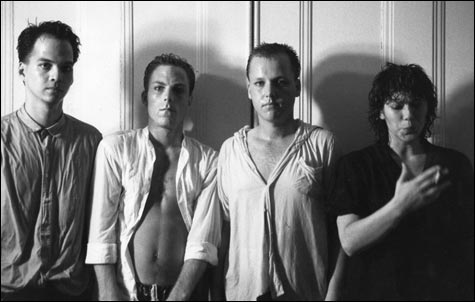
RENEGADES: Like other bands of the time, the Pixies had a passion for surf music, punk rock, and marking their own territory. |
| View results and more from this year's Phoenix/WFNX Best Music Poll at BestMusicPoll.com. |
Twenty years ago, the American Top 40 was nothing like Boston’s live music scene. Sure, Guns N’ Roses, George Harrison, and Cheap Trick put songs on the chart, but otherwise acts like Whitney Houston, Chicago, Poison, INXS, Rick Astley, Tiffany, and Billy Ocean ruled the nation’s soft-pop, dance music, and hair-metal-fixated tastes.Boston was, and pretty much remains, a guitar town, even if today more of those guitars are held by singer-songwriters than blood ’n’ guts rockers. But within that six-string driven sensibility, there’s always been a little room for the quirky. Especially in ’88, when the scent of the punk revolution was still fresh and the shockwaves from creative firecrackers like the city’s own Mission of Burma and frequent visitors Hüsker Dü bristled through the local music community.
The scene wasn’t just tolerant. It encouraged oddness. One of the big winners in the Phoenix/WFNX Best Music Poll’s first year, 1989 — which reflected 1988’s action — was Ed’s Redeeming Qualities, a folky outfit that included a portly man named Neno Perotta playing a shaker made from a coffee can. Sometimes Perotta performed shirtless. He always sweated copiously on stage. Despite this, the band took the Best Local Folk category and placed for Best New Artist.
Another group featuring a portly guy who sweated a lot under the lights — the Pixies, led by a singer who called himself Black Francis — fared less well in the initial Best Music Poll. Like Ed’s, the Pixies placed in the Best New Artist category, which was won by the now woefully obscure Lemmings. And the Pixie’s second disc, Surfer Rosa (4AD), was a runner-up in the Best Local Record/Tape/CD category to a winning demo called Bang-a-lang by Mike Viola and Snap.
Well, the “snap” was on the Best Music Poll and its voters, because Surfer Rosa became one of the most influential albums of the ’80s. Today it’s widely considered the foundation of the post-punk scene’s more artistically and commercially ambitious offshoot, alternative rock.
When it arrived, Surfer Rosa was riveting and ramshackle, full of evocative imagery and noisy outbursts. Many budding artists, including Polly Jean Harvey, Kurt Cobain, Billy Corgan, and the members of Radiohead and Catherine Wheel, heard its siren’s call and followed.
But the truth is, the Pixies were still a terrible live band in 1988, barely able to negotiate their instruments. Yet they were enlightened primitives, with bright ideas about sound and the structure and substance of songs. And those qualities made Surfer Rosa and the Pixies remarkable — if not exactly popular. Even in Boston’s tolerant musical cauldron they were oddballs without much of a following until 1992, when a chain of major-label releases, airplay, and gigs with U2 accumulated to elevate them. A year later, they broke up.
But back in 1986, the foursome were a fresh-faced outfit making their first demo. Like plenty of other Boston club rats, producers Sean Slade and Paul Kolderie didn’t quite know what to make of the fledgling outfit.
“We were still trying to suss them out,” Slade said several years ago, recalling the sessions. “We knew that although they were primitive musicians, they had something really interesting and personal happening. But when Black Francis began singing — howling, really — his lyrics about fire-and-brimstone Biblical stuff and insanity, our jaws just dropped. There he was in our makeshift vocal booth, and it was magical.”
Slade and Kolderie have gone on to produce classic albums with Radiohead, Hole, the Mighty Mighty Bosstones, and many others. The so-called “Purple Tape” cassette demo the Pixies made with them became the basis for the group’s raw debut EP Come on Pilgrim (4AD).
By 1988, the Pixies had grown enough to write and create their masterpiece, Surfer Rosa. This abrasive cornerstone of alternative rock was released in March. It was knotty, noisy, and gnarled, with songs hinging on God, blood lust, and high school gossip — not at all typical ’80s pop themes — amid a whirlwind of jittery arrangements.
The disc sounded alien even in Boston’s musical milieu. Garage rock was king then. Nonetheless, the Pixies were compatible with a few other noisy innovators in town: their friends Throwing Muses and Thalia Zedek’s band Uzi. Their rumpled, angular sound seemed like an evolutionary step from predecessors like the Hub’s Mission of Burma, Cleveland’s Pere Ubu, and the bands in New York City’s No Wave scene, where Lydia Lunch’s Teenage Jesus & the Jerks and Richard Hell and the Voidoids had ruled the loft-space clubs of Lower Manhattan. What all those bands shared was an interest in surf music, the punk rock aesthetic, and a passion for marking their own territory, no matter whose feet they wet.